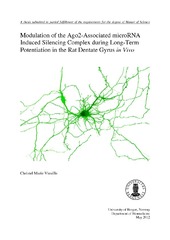Modulation of the Ago2-Associated microRNA Induced Silencing Complex during Long-Term Potentiation in the Rat Dentate Gyrus in Vivo
Master thesis
Permanent lenke
https://hdl.handle.net/1956/5936Utgivelsesdato
2012-05-30Metadata
Vis full innførselSamlinger
Sammendrag
Synaptic plasticity is defined as the ability of a neuronal synapse to change in strength, and is believed to be the basis of learning and memory. An example of synaptic plasticity, by far the most studied, is long-term potentiation (LTP): a stable, activity-induced increase in synaptic efficacy. LTP requires de novo gene expression, protein synthesis and protein degradation. Transcriptional and post-transcriptional regulation controls new protein expression. In the past decade, small non-coding RNAs called microRNAs have emerged as key regulators of translation. MicroRNAs bind to target mRNAs by complementary binding and recruit a protein complex to mediate mRNA silencing. This complex is known as the microRNAinduced silencing complex (miRISC). The goals of this study were to investigate the composition of the miRISC in the rat dentate gyrus in vivo, to study modulation of the miRISC during LTP, and to uncover new candidate binding partners of Ago2. LTP was induced by HFS of the medial perforant path. The miRISC was isolated by immunoprecipitation of its core component, the protein Argonaute 2 (Ago2). Five proteins thought to bind Ago2 were analyzed by co-immunoprecipitation with Ago2. These proteins were GW182, the RNase III enzyme, Dicer, the RNA-binding protein, FMRP, and the RNA helicases, MOV10 and DDX6. DDX6 was the only protein found to be reliably associated with Ago2, even though all the proteins were detected in association with Ago2 in HEK cells expressing EGFP-Ago2. DDX6 was non-significantly dissociated from Ago2 during LTP. In the total lysate, none of the analyzed proteins were significantly modulated during LTP. Nevertheless, Argonaute 2 and GW182 were non-significantly upregulated, and MOV10 was non-significantly downregulated during LTP. The study does not show a significant remodeling of the miRISC during LTP, but neither does it exclude this possibility. Immunoprecipitated samples were analyzed by mass spectrometry. New candidate Ago2 binding partners were uncovered, such as the proteins DDX1 and FXR1, homologs of DDX6 and FMRP. A protein important for translation, poly-A-binding protein 1 (PABP1), was also detected.
